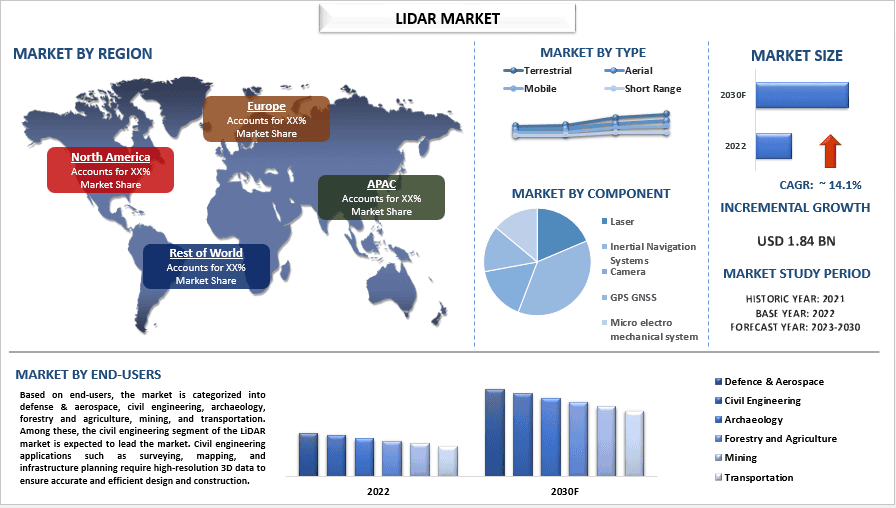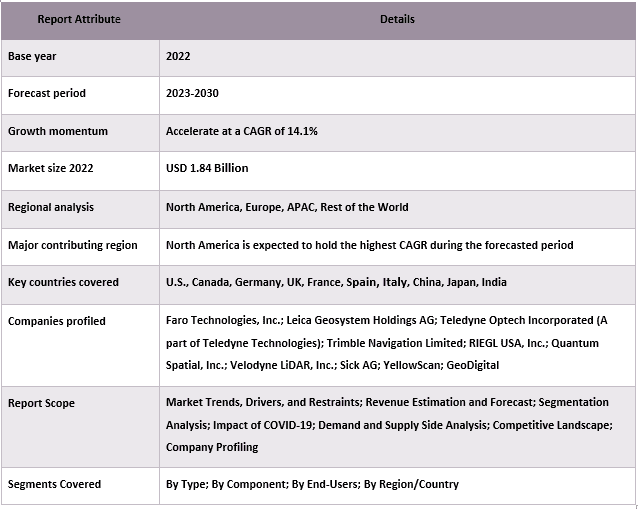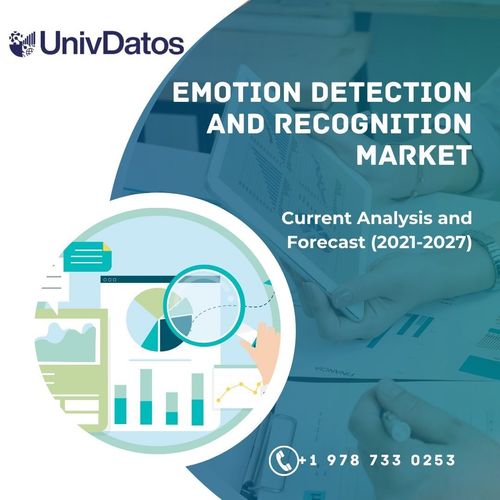LiDAR Market: Current Analysis and Forecast (2023-2030)
Emphasis on Type (Terrestrial, Aerial, Mobile, And Short range); Component (Laser, Inertial Navigation Systems, Camera, GPS GNSS, And Micro Electro Mechanical System); End-users (Defense & Aerospace, Civil Engineering, Archaeology, Forestry And Agriculture, Mining, And Transportation) and Region/Country

The LiDAR Market was valued at 1.84 billion in 2022 and is expected to grow at a steady rate of around 14.1% in the forecasted period (2023-2030). Lidar (Light Detection and Ranging) Technology is an advanced remote sensing method that uses light in the form of laser pulses to measure distances between objects. It allows for accurate three-dimensional mapping, monitoring changes over time, detection of obstacles, and creating digital elevation models. Lidar has applications across various fields such as geology, archaeology, surveying, autonomous vehicles, meteorology, astronomy, and environmental research. This market is booming due to its crucial role in various industries like autonomous vehicles, robotics, and environmental monitoring. Its ability to provide accurate and real-time 3D mapping makes it indispensable for applications requiring precise spatial data. As technology advances, the demand for LiDAR is likely to keep growing. For instance, according to the United States Department of Agriculture (USDA), the demand for aerial surveys and maps has increased significantly in recent years, driven by the adoption of drones equipped with LiDAR sensors.
Some of the major players operating in the market include Faro Technologies, Inc.; Leica Geosystem Holdings AG; Teledyne Optech Incorporated (A part of Teledyne Technologies); Trimble Navigation Limited; RIEGL USA, Inc.; Quantum Spatial, Inc.; Velodyne LiDAR, Inc.; Sick AG; YellowScan; GeoDigital.
Insights Presented in the Report
“Among type, the aerial segment is currently the leading segment of the market during forecast period.”
Based on type, the market is categorized into terrestrial, aerial, mobile, and short range. Among these, the aerial segment of the LiDAR market is expected to lead the market due to its increasing adoption in various applications such as surveying, mapping, and agriculture. Aerial LiDAR technology uses light detection and ranging sensors mounted on aircraft or drones to capture high-resolution 3D data of the earth’s surface. This technology has gained significant traction in recent years due to its ability to provide accurate and detailed information over large areas quickly and efficiently. For instance, in 2020, the USDA reported that there were over 178,000 commercial drone pilots in the United States alone, up from just 46,000 in 2017.
“Amongst end-users, civil engineering to witness significant market growth during the forecast period.”
Based on end-users, the market is categorized into defense & aerospace, civil engineering, archaeology, forestry and agriculture, mining, and transportation. Among these, the civil engineering segment of the LiDAR market is expected to lead the market. Civil engineering applications such as surveying, mapping, and infrastructure planning require high-resolution 3D data to ensure accurate and efficient design and construction. LiDAR technology provides detailed point clouds and 3D models that enable engineers to visualize and analyze complex infrastructure projects such as bridges, roads, and buildings. Therefore, adding great values to the demand of the market.
“North America to hold a significant share in the market.”
The North America region is expected to dominate the LiDAR market due to the increasing adoption of autonomous vehicles and drones equipped with LiDAR sensors. Moreover, the demand for LiDAR technology in the region is also driven by the increasing need for accurate and reliable 3D data for various applications such as surveying, mapping, civil engineering, agriculture, mining, and transportation. Also, the growing demand for autonomous vehicles and drones equipped with LiDAR sensors is expected to drive the growth of the LiDAR market in the region.
LiDAR Market Report Coverage

Reasons to buy this report:
- The study includes market sizing and forecasting analysis validated by authenticated key industry experts.
- The report presents a quick review of overall industry performance at one glance.
- The report covers an in-depth analysis of prominent industry peers with a primary focus on key business financials, product portfolio, expansion strategies, and recent developments.
- Detailed examination of drivers, restraints, key trends, and opportunities prevailing in the industry.
- The study comprehensively covers the market across different segments.
- Deep dive regional level analysis of the industry.
Customization Options:
The global LiDAR Market can further be customized as per the requirement or any other market segment. Besides this, UMI understands that you may have your own business needs, hence feel free to contact us to get a report that completely suits your requirements.
Table of Contents
Research Methodology for the LiDAR Market Analysis
(2023-2030)
Analyzing the historical market, estimating the current market, and forecasting the future market of the global LiDAR Market were the three major steps undertaken to create and analyze the adoption of LiDAR in major regions globally. Exhaustive secondary research was conducted to collect the historical market numbers and estimate the current market size. Secondly, to validate these insights, numerous findings and assumptions were taken into consideration. Moreover, exhaustive primary interviews were also conducted, with industry experts across the value chain of the global LiDAR Market. Post assumption and validation of market numbers through primary interviews, we employed a top-down/bottom-up approach to forecasting the complete market size. Thereafter, market breakdown and data triangulation methods were adopted to estimate and analyze the market size of segments and sub-segments of the industry pertains to. Detailed methodology is explained below:
Analysis of Historical Market Size
Step 1: In-Depth Study of Secondary Sources:
Detail secondary study was conducted to obtain the historical market size of the LiDAR Market through company internal sources such as annual reports & financial statements, performance presentations, press releases, etc., and external sources including journals, news & articles, government publications, competitor publications, sector reports, third-party database, and other credible publications.
Step 2: Market Segmentation:
After obtaining the historical market size of the LiDAR Market, we conducted a detailed secondary analysis to gather historical market insights and share for different segments & sub-segments for major regions. Major segments are included in the report as type, component, end-users. Further country-level analyses were conducted to evaluate the overall adoption of testing models in that region.
Step 3: Factor Analysis:
After acquiring the historical market size of different segments and sub-segments, we conducted a detailed factor analysis to estimate the current market size of the LiDAR Market. Further, we conducted factor analysis using dependent and independent variables such as various type, component, end-users of LiDAR. A thorough analysis was conducted of demand and supply-side scenarios considering top partnerships, mergers and acquisitions, business expansion, and product launches in the LiDAR Market sector across the globe.
Current Market Size Estimate & Forecast
Current Market Sizing: Based on actionable insights from the above 3 steps, we arrived at the current market size, key players in the global LiDAR Market, and market shares of the segments. All the required percentage shares split, and market breakdowns were determined using the above-mentioned secondary approach and were verified through primary interviews.
Estimation & Forecasting: For market estimation and forecast, weights were assigned to different factors including drivers & trends, restraints, and opportunities available for the stakeholders. After analyzing these factors, relevant forecasting techniques i.e., the top-down/bottom-up approach were applied to arrive at the market forecast for 2030 for different segments and sub-segments across the major markets globally. The research methodology adopted to estimate the market size encompasses:
- The industry’s market size, in terms of revenue (USD) and the adoption rate of the LiDAR Market across the major markets domestically
- All percentage shares, splits, and breakdowns of market segments and sub-segments
- Key players in the global LiDAR Market in terms of products offered. Also, the growth strategies adopted by these players to compete in the fast-growing market.
Market Size and Share Validation
Primary Research: In-depth interviews were conducted with the Key Opinion Leaders (KOLs) including Top Level Executives (CXO/VPs, Sales Head, Marketing Head, Operational Head, Regional Head, Country Head, etc.) across major regions. Primary research findings were then summarized, and statistical analysis was performed to prove the stated hypothesis. Inputs from primary research were consolidated with secondary findings, hence turning information into actionable insights.
Split of Primary Participants in Different Regions

Market Engineering
The data triangulation technique was employed to complete the overall market estimation and to arrive at precise statistical numbers for each segment and sub-segment of the global LiDAR Market. Data was split into several segments & sub-segments post studying various parameters and trends in the areas of type, component, end-users in the global LiDAR Market.
The main objective of the Global LiDAR Market Study
The current & future market trends of the global LiDAR Market were pinpointed in the study. Investors can gain strategic insights to base their discretion for investments on the qualitative and quantitative analysis performed in the study. Current and future market trends determined the overall attractiveness of the market at a regional level, providing a platform for the industrial participant to exploit the untapped market to benefit from a first-mover advantage. Other quantitative goals of the studies include:
- Analyze the current and forecast market size of the LiDAR Market in terms of value (USD). Also, analyze the current and forecast market size of different segments and sub-segments.
- Segments in the study include areas of type, component, end-users.
- Define and analysis of the regulatory framework for the LiDAR industry.
- Analyze the value chain involved with the presence of various intermediaries, along with analyzing customer and competitor behaviors of the industry.
- Analyze the current and forecast market size of the LiDAR Market for the major region.
- Major countries of regions studied in the report include Asia Pacific, Europe, North America, and the Rest of the World.
- Company profile of the LiDAR Market and the growth strategies adopted by the market players to sustain in the fast-growing market.
- Deep dive regional level analysis of the industry
Frequently Asked Questions FAQs
Q1: What is the current market size and growth potential of the global LiDAR Market?
Q2: What are the driving factors for the growth of the global LiDAR Market?
Q3: Which segment has the largest share of the global LiDAR Market by component?
Q4: Which region will dominate the global LiDAR Market?
Q5: Who are the key players operating in the global LiDAR Market?
Related Reports
Customers who bought this item also bought










